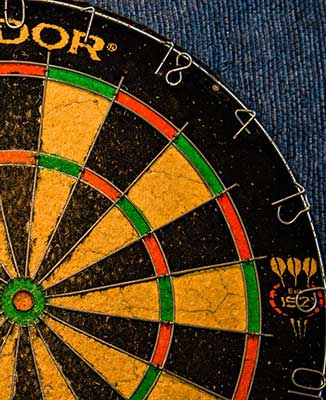Dart Rules
Scoring
The standard dartboard is divided into 20 numbered sections, scoring from 1 to 20 points, by wires running from the small central circle to the outer circular wire. Circular wires within the outer wire subdivide each section into single, double and triple areas. In the official game, any dart landing inside the outer wire scores as follows:
- Hitting one of the large portions of each of the numbered sections, traditionally alternately colored black and white, scores the points value of that section.
- Hitting the thin inner portions of these sections, roughly halfway between the outer wire and the central circle colored red and green, scores triple the points value of that section.
- Hitting the thin outer portions of these sections, again coloured red or green, scores double the points value of that section. The double-20 is often referred to as double-top, reflecting the 20's position on the dartboard.
- The central circle is divided into a green outer ring worth 25 points (known as"outer", "outer bull", or "iris") and a red inner circle (usually known as "bull","inner bull" or "double bull"), worth 50 points. The term "bullseye" can mean either the whole central part of the board or just the inner red section. The term
"bull's ring" usually means just the green outer ring. - Hitting outside the outer wire scores nothing.
- Any dart that does not remain in the board after throwing (for example, a dart that hits a wire and bounces out of the board or drops out with the impact of a later throw) also scores nothing; exception should be noted if play is on any electronic board: darts falling out are counted.
The highest score possible with three darts is 180, commonly known as a "ton 80" (100 points is called a ton), obtained when all three darts land in the triple 20.
Playing darts
Darts generally refers to a game whereby the player throws three darts per visit to the board with the goal of reducing a fixed score, commonly 501 or 301, to zero, with the final dart landing in either the bullseye or a double segment. A game of darts is generally contested between two players, or two teams, who take turns in throwing up to three darts.
A throw that reduces a player's score below zero, to exactly one, or to zero but not ending with a double is known as "going bust", with that player's score being reset and their turn forfeited. A darts match is played over a fixed number of games, known as legs. A match may be divided into sets, with each set being contested as over a fixed
number of legs.
Although playing straight down from 501 is standard in darts, sometimes a double must be hit to begin scoring, known as "doubling in", with all darts thrown before hitting a double not being counted.
